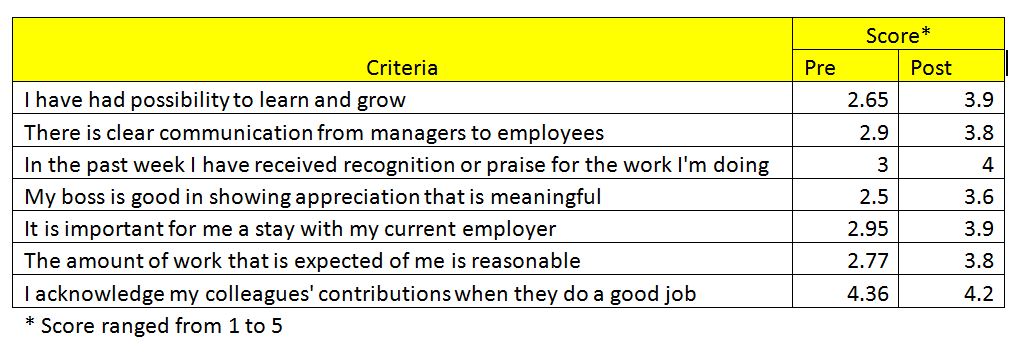This post is somewhat different and very special. Anita and her message on the five languages of appreciation have had a profound effect on me and I am sure it will have one on you too. Therefore, Anita and I have decided to present a 4-part series on the power of appreciation on 4 different yet very much interrelated fronts: at workplace, among partners, parents with young children, and parents with teens.
Also, in each of the series, Anita has 10 Tips to offer to start implementing appreciation.
Here’s the first in the series of four.
Enjoy!
Want to Reduce Employee Turnover? Speak Their Language of Appreciation
By Cand.Polit Anita Fevang and Sudiksha Joshi, Ph.D.
“The deepest principle in human nature is the craving to be appreciated.”
– William James
John just received a public recognition for his contribution at work for the fifth time in a row but he doesn’t care for this recognition. In fact, as he headed down the podium, he was thinking of an exit plan. With all the accolades and good perks, John does not feel appreciated in his organization.
Did you know that the primary reason that employees quit their jobs is because they don’t feel appreciated or validated? In fact, according to the 2014 TINYpulse Employee Engagement and Organizational Culture Report, 79% of the employees who quit do so because they don’t feel appreciated. Lack of appreciation means fewer results, lower customer satisfaction, less engagement, and a negative work environment with high turnover rates and more sick notes. The resulting cost to the organization is obvious and therefore warrants further investigation.
In order to create an appreciative workplace, we need to understand the mechanics of feelings and habits. So, an important question is: Where does a feeling come from?
According to the principle of cognitive-behavioural therapy, emotions don’t just “happen.” Our emotional response to an event is not an automatic response to that event “happening to us. When an event occurs, we evaluate and add meaning to what transpired during that event, which then creates a feeling, which then leads to a behavior, and then a consequence. For example, if someone cut you off on the highway, you think “he really disrespected me.” You then get angry not because of the event (him cutting you off) but because of the feeling (being disrespected). As a consequence of that feeling, you speed up and cut him off, which eventually ended up in you getting a speeding ticket. To recap, this was the order:

Cognitive Behavior with regards to an Emotional Response
So, how can we create a motivating and an encouraging work environment where employees both feel appreciated and also reciprocate genuine appreciation towards the company and their colleagues? How do we make sure that the need to appreciate your colleagues is not a mere formality and but rather a genuine organizational practice. It will do no good if words float around the organization about the importance of appreciating your colleagues if the employees feel that there really isn’t anything to appreciate about. Besides, faking it will destroy relationships anyway since fake appreciation creates a lack of trust.
Now that we know that our emotions are a result of our thoughts, we can change our feelings, and therefore our actions/behavior and consequences. Yes, we can change our emotions by changing our perspective or interpretation of that event. Isn’t this empowering to know that our emotions don’t control us but rather we can manage our feelings through managing our thoughts? It is not an easy task but yes, we can manage our thoughts by changing our automated habits.
Ivar Haugstad, an anthropologist and founder of the organization “Faculty of Encouragement”, said that unproductive thoughts that feed our irritation and lack of appreciation can be managed. Yes, you can manage negative feelings that can lead to negative comments. And, you can also develop new thought patterns that will allow you to manage your frustration.
Ivar suggested that in order to make new habits, changes need to be small and easy to follow through. These changes should be part of your daily practice, and ideally, you should commit to trying it out for a set amount of time to start with, i.e. 30 days.
So, what would be an easy step toward forming a new habit for improving appreciation levels at work look like? How about getting into a habit of noticing and communicating two things you appreciate before going to work, and two things you appreciate about your colleagues at work?
What could we appreciate before work?
How about the hot and clean water in our shower? Maybe express appreciation for your cup of coffee and clean clothes? Or for the inviting signs of spring or a beautiful sunrise? Remember – you only need two small things to appreciate every day – for a month.
Now, what is there to appreciate at work?
Most organizations have recognition systems in place. However, most often than not, they don’t work. Those recognition systems are too general, appear externally driven and lack personal touch and authenticity. Those systems mostly likely aren’t in line with the language that the recipient “understands.” People often miss being appreciated for who they are or their personality. They don’t like being complimented solely on their performance. So, you could appreciate someone’s friendly tone of voice or smile. You could also appreciate their enthusiasm or punctuality. Remember; you just need two small things to be appreciative of each day.
Watch Anita’s 10 Tips for showing appreciation at Work
In the book, The 5 Languages of Appreciation in the Workplace, Dr. Chapman and Dr. White showed that there are five ways in which to show appreciation. They call it the five languages:
• Words of Affirmation,
• Quality Time,
• Acts of Service,
• Gifts, and
• Physical Touch
Even though every individual likes all five, there is one or two language(s) in particular, that really “speaks to their heart”. For John, words of affirmation (public praise) is not his primary language of affirmation, quality time is. John’s boss has hardly taken the time to talk to John about his progress, asked him for suggestions to improve the work environment. Since John’s boss has not taken the time to understand John’s language of appreciation, John feels unappreciated and is ready to move on.
I (Anita Fevang) have been on a mission to bring Appreciation at Workplaces. The transformation in the level of motivation among employees and therefore the motivation to be more productive and remain loyal to their workplace after implementing the 5 Languages of Appreciation at Work is inspiring. As an example, I present the pre and post assessment findings of the Appreciation at Work Workshop at the Tjøme Municipality in Rødstoppen, Norway.
It was interesting to see that in just 3 months after delivering the workshop, the employees showed significantly greater improvement in communication, in receiving appreciation, and most importantly in valuing their workplace. It was also noteworthy that the same amount of workload seemed to be more reasonable. One surprising result was the decrease in the employees’ perception of whether they acknowledged their colleague’s contributions. I suspect that this result is due to their higher awareness towards their colleagues’ appreciation needs and being unsure if their efforts in showing appreciation were enough.
Pre and Post Assessment of the Appreciation at Work Workshop , Tjøme Municipality in Rødstoppen, Norway

As a first step to recognizing the language of appreciation of your employees, a 15-minute online Motivation by Appreciation or the MBA test can tell you what each person’s needs are that “hit the nail on the head.” If your department chooses to do a group test, you will also be able to make a Group Profile that you could stick up on the wall, where it’s easy for everyone to see. This will help you get a daily reminder of what your colleagues need in order to feel appreciated.
So, make it an exercise to get into the habit of showing appreciation in a language important to a colleague at least twice a day. For example, if you know that Jonathan is coming in and that his preferred language of appreciation is Acts of Service, you could empty the bin for him. Or if Laura’s language of appreciation is Words of Affirmation, you could remember to let her know how her encouragement before that meeting meant to you.
Small everyday acts of appreciation matter. It is easy, it is a habit, a choice, and above all, it is transformational. Please let us know what two things will you be appreciative of today as a way to change your emotions for the day and therefore change your work environment.






